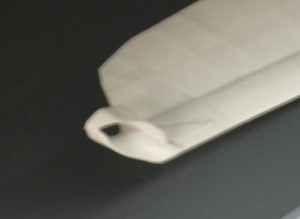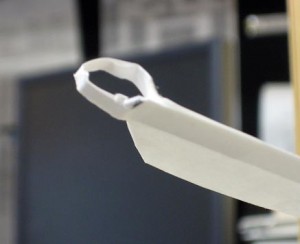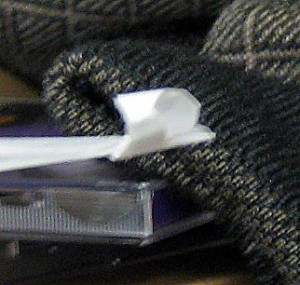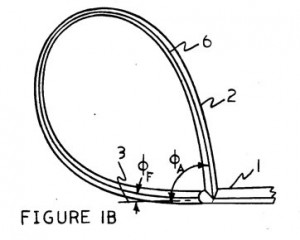
With a traditional barnaby,
 the paper is folded in half both ways to establish the keel and the leading edge. The winglet is just as thick as the leading edge. The paper for the spiroid is folded on a diagonal, corner to opposite corner, then trimmed for symmetry (a diamond). The leading edge is folded up from a wide corner, so the narrow corners become the wingtips. There is only one or two thicknesses of paper there. A ribbon curl, tape to hold the tip to the wing, a diagonal cut, and a spiroid. It is not completely there, as the true spiroid has a slightly more complex shape.
the paper is folded in half both ways to establish the keel and the leading edge. The winglet is just as thick as the leading edge. The paper for the spiroid is folded on a diagonal, corner to opposite corner, then trimmed for symmetry (a diamond). The leading edge is folded up from a wide corner, so the narrow corners become the wingtips. There is only one or two thicknesses of paper there. A ribbon curl, tape to hold the tip to the wing, a diagonal cut, and a spiroid. It is not completely there, as the true spiroid has a slightly more complex shape.



The proper shape for a spiroid. I apologize for the out-of-focus.
The photo below is tricky. The narrow part is at the rear, the wider part at the inside, attached to the wing with a sharp fold up. 


Figure from patent, Spiroid-Tipped Wing, # 5,102,068 issued to Louis B. Gratzer, April 7, 1992.
The plane was made using a traditional fold of half in each direction. Unfolded, I folded in the corners at the front, cut them off, and tucked them in when folding up the leading edge, to get the weight up front. The wing is thick in the center and thin at the ends. The wingtips were rolled up on a pencil and a tab was taped to the wing. Then the cylinders formed were trimmed into a spiral. Spiroids.
The flight test was quite successful. After some adjustments for trim, it was clear the plane flew with great authority, righting itself quickly, with long glides to a landing. My sense is the spiroids are riding the vortices shed at the wingtips.
Spiroids
Spiroid Winglets, which look like a large loop of rigid ribbon material attached to each wingtip, cut fuel consumption by 6% – 10% in cruise flight. Initial flight tests of the Aviation Partners Spiroid concept on a GII reportedly reduced cruise fuel consumption by more than 10%. Stay tuned for more developments on this promising technology.